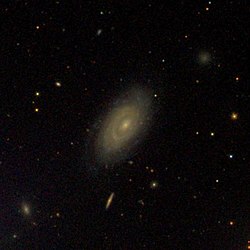NGC 5821
| Galaxie NGC 5821 | |
|---|---|
 | |
| SDSS-Aufnahme | |
| AladinLite | |
| Sternbild | Bärenhüter |
| Position Äquinoktium: J2000.0, Epoche: J2000.0 | |
| Rektaszension | 14h 58m 59,6s [1] |
| Deklination | +53° 55′ 24″ [1] |
| Erscheinungsbild | |
| Morphologischer Typ | S?[1] |
| Helligkeit (visuell) | 13,7 mag[2] |
| Helligkeit (B-Band) | 14,6 mag[2] |
| Winkelausdehnung | 1,4′ × 0,8′[2] |
| Positionswinkel | 148°[2] |
| Flächenhelligkeit | 13,7 mag/arcmin²[2] |
| Physikalische Daten | |
| Zugehörigkeit | LGG 395[1][3] |
| Rotverschiebung | 0,011261 ± 0,000037[1] |
| Radialgeschwindigkeit | (3376 ± 11) km/s[1] |
| Hubbledistanz H0 = 73 km/(s • Mpc) | (157 ± 11) · 106 Lj (48,2 ± 3,4) Mpc [1] |
| Geschichte | |
| Entdeckung | Wilhelm Herschel |
| Entdeckungsdatum | 24. April 1789 |
| Katalogbezeichnungen | |
| NGC 5821 • UGC 9648 • PGC 53532 • CGCG 273-039, 274-005 • MCG +09-25-002 • IRAS F14575+5407 • 2MASX J14585972+5355234 • GC 4030, 4028 • H III 811 • LDCE 1103 NED002 | |
NGC 5821 ist eine Spiralgalaxie vom Hubble-Typ S? im Sternbild Bärenhüter. Sie ist schätzungsweise 157 Millionen Lichtjahre von der Milchstraße entfernt und hat einen Scheibendurchmesser von etwa 65.000 Lj. Möglicherweise steht sie in Wechselwirkung mit NGC 5820.
Das Objekt wurde am 24. April 1789 von Wilhelm Herschel mit einem 18,7-Zoll-Spiegelteleskop entdeckt,[4] der sie dabei mit „vF, S, E“[5] beschrieb.
Weblinks
- NGC 5821. SIMBAD, abgerufen am 26. April 2016 (englisch).
- NGC 5821. DSO Browser, abgerufen am 26. April 2016 (englisch).
Einzelnachweise
Auf dieser Seite verwendete Medien
Autor/Urheber: Sloan Digital Sky Survey, Lizenz: CC BY 4.0

Angle of view: 4' × 4' (0.3" per pixel), north is up.
Details on the image processing pipeline: https://www.sdss.org/dr14/imaging/jpg-images-on-skyserver/